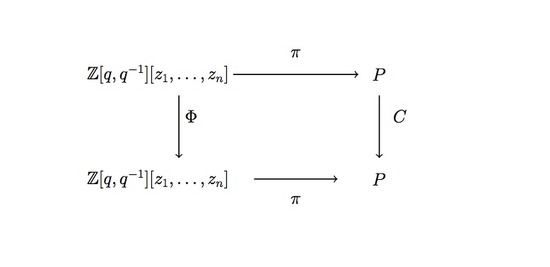Macdonald Polynomials and Demazure Characters
( \newcommand{\kernel}{\mathrm{null}\,}\)
Introduction
We will here discuss the connection between nonsymmetric Macdonald polynomials and the characters of Demazure modules for ^sl(n) as given in [3]. We assume a familiarity with affine (untwisted) Lie algebras, specifically ^sl(n), but will give all necessary facts about Demazure modules and nonsymmetric Macdonald polynomials here.
Nonsymmetric Macdonald Polynomials
Recall that nonsymmetric Macdonald polynomials Eλ(z1,…zn,q,t) are indexed by compositions λ∈Nn and that they form a basis of C(q,t)[z1,…,zn]. Henceforth we specialize to t=0, and write
Eλ=Eλ(z1,…,zn,q,0).
We can generate these polynomials recursively via the endomorphisms Φ,H0,H1,…,Hn−1 acting on the space Z[q,q−1][z1,…,zn] (note that when we specialize to t=0 we drop from the space C(q,t)[z1,…,zn] to Z[q,q−1][z1,…,zn]). Φ,H1,…,Hn−1, are defined such that
¯Hi=si−zi+11−sizi−zi+11≤i≤n−1
Φf(z1,…,zn)=znf−1(q−1zn,z1,…,zn−1)
There is an ˉH0 too but we will not discuss it. The recursive rules tell us that after setting E(0n)=1, then
qλ1ΦE(λ1,…,λn)=E(λ2,…,λn,λ1+1)
qλ1−λn+1¯H0Eλ=E(λn−1,λ2,…,λn−1,λ1+1)if λ1>λn−1
and otherwise qλ1−λn+1¯H0Eλ=Eλ. Finally,
¯HiEλ=Esiλif λi<λi+1
and otherwise ¯HiEλ=Eλ. These operators should be reminiscent of the action of the Weyl group of ^sl(n) on compositions.
As an example suppose that for n=3 we want to generate E(1,2,1). Then we could apply the composition ¯H2Φ4 to E(0,0,0) to get
Φ(E(0,0,0))=E(0,0,1)=z3,
Φ(E(0,0,1))=E(0,1,1)=z2z3,
Φ(E(0,1,1))=E(1,1,1)=z1z2z3,
Φ(E(1,1,1))=E(1,1,2)=z1z2z23,
¯H2(E(1,1,2))=E(1,2,1)=z1z22z3+z1z2z23
Demazure Modules
In this section we let g be a Kac-Moody algebra associated with Cartan datum (h,Π,Π∨,P,P∨). We closely follow chapter 2 of [1]. Recall that a g-module V is a weight module if it admits a weight space decomposition:
V=⨁μ∈h∗Vμ
where
Vμ={v∈V|hv=μ(h)vfor allh∈h}
A vector v∈Vμ is called a weight vector of weight μ if eiv=0 for all i∈I, v is called a maximal weight vector. The dimension dimVμ is called the weight multiplicity of μ. When dimVμ<∞ for all μ, the
character of V is defined to be
chV=∑μdimVμeμ
where eμ are formal basis elements of the group algebra F[h∗] with multiplication eλeμ=eλ+μ. We call a g-module V a highest weight module of highest weight λ∈h∗ if there exists a nonzero vector vλ∈V such that
eivλ=0for all i∈I,
hvλ=λ(h)vfor all h∈h,
V=U(g)vλ( or U−vλ=V),
where we here use the decomposition U(g)≅U−⊗U0⊗U+ of the universal enveloping algebra of g. An element Λ∈h∗ is a dominant integral weight if Λ belongs to the set,
P+={Λ∈P|λ(hi)∈Z≥0for all i∈I}
The irreducible highest weight g-modules V(Λ) where Λ is a dominant integral weight have the special property that the Chevalley generaters ei and fi are locally nilpotent on V(Λ). This allows us to construct a well-defined automorphism
τi=(expfi)(exp(−ei))(expfi)
where the action of τi on weight spaces is given by
τiVλ=Vsiλfor all i∈I,λ∈wt(V)
here si denotes the generator of the Weyl group associated with g with index i.
If we still assume that Λ is a dominant integral weight, V=V(Λ) the unique irreducible highest weight ^sl(n)-module with highest weight Λ, then the weight space Vw(Λ) of weight w(Λ) generates a U+(^sl(n)-module, Ew(Λ) which is called a Demazure module. Note that Demazure modules are finite dimensional, and also that they form a filtration on V(Λ) which is compatible with the Bruhat order on W:
w≤w′⟹Ew(Λ)⊆Ew′(Λ)
We can also define Demazure operators that act on the group ring of the weight lattice P:
Δi=1−e−αisi1−e−αi
where si is the simple reflection in the Weyl group with respect to simple root αi. To w∈W with reduced decomposition w=si1si2…sij we can then associate the Demazure operator
Δw=Δi1Δi2…Δij,
There is a nice connection between characters and Demazure operators given by the formula [2]:
χ(Ew(Λ))=Δw(eΛ).
The Connection
We let Λ0,Λ1,…,Λn−1 be the n-fundamental weights of ^sl(n). Recall that these Λi are defined such that (Λi,αj)=δij. Finally,
δ=n−1∑i=0αi.
For the connection between Eλ and characters of Demazure modules we want to relate the action of ¯Hi and Φ to operators on P. More specifically, we would like a commutative diagram

We can get this by defining π:Z[q,q−1][z1,…,zn]→P on generators by
π(zi)=eΛi−1−Λi,π(zn)=eΛn−1−Λ0,π(q)=e−δ.
(note that this definition is slightly different to that found in the paper). We get a similar commutative diagram for Φ:

The main result of [3] is then that through the homomorphism π, we can identify
q−u(λ)+u(ηλ)Eλwithχ(Ew(Λi))
where u(λ) and ηλ (this is a partition) depend only on λ and i=|λ|modn and where w is an specific affine Weyl group element defined such that w acts on η|λ| to give λ.
References
- J. Hong and S.J. Kang. Introduction to quantum groups and crystal bases, volume 42 of Graduate Studies in Mathematics. American Mathematical Society, Providence, RI, 2002.
- S. Kumar, Demazure character formula in arbitrary Kac-Moody setting, Invent. Math. 89 (1987), 395-423.
- Y. Sanderson, On the connection between Macdonald polynomials and Demazure characters, J. Algebraic Combin. 11 (2000), no.3, 269-275.

